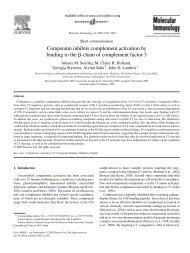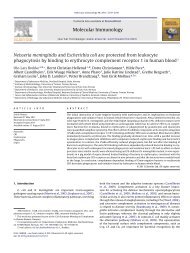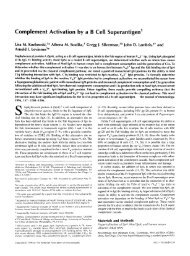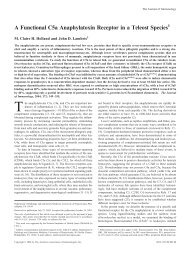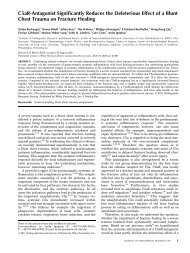IDENTIFICATION OF A C3bi-SPECIFIC ... - John D. Lambris
IDENTIFICATION OF A C3bi-SPECIFIC ... - John D. Lambris
IDENTIFICATION OF A C3bi-SPECIFIC ... - John D. Lambris
Create successful ePaper yourself
Turn your PDF publications into a flip-book with our unique Google optimized e-Paper software.
GORDON D. ROSS AND JOHN D. LAMBRIS 103<br />
cytes from six normal individuals demonstrated that 86% of cells bearing CRz or CR3<br />
also expressed membrane Ig detectable with F(ab')2-anti-Ig. No CR2-positive cells<br />
were detected that expressed either Leu-1 or 3AI T cell determinants. Among the<br />
CRa-positive blood lymphocytes, 5% of cells stained with either anti-Leu-1 or anti-<br />
3A1, and 16% of cells stained with anti-OKM-1. Tonsils contained a considerably<br />
higher proportion of CR3-bearing cells than did peripheral blood. However, unlike<br />
blood lymphocytes, the majority of tonsil CRa-positive cells expressed CR2 because<br />
the percentage of cells binding either <strong>C3bi</strong>-ms or C3d-ms was nearly equal. All three<br />
B type lymphoblastoid cell lines examined expressed CR3 on a proportion of the cells.<br />
Discussion<br />
The major finding in the present study is that lymphocytes, monocytes, neutrophils,<br />
and erythrocytes express a <strong>C3bi</strong>-specific membrane C receptor (CRa) that is distinct<br />
from CR1 and CR2. CRa is specific for <strong>C3bi</strong> and unreactive with C3b, C3c, and C3d.<br />
Neutrophils and monocytes lack detectable CR2 at all stages of maturation and bind<br />
<strong>C3bi</strong> complexes exclusively to CRa. Neutrophils begin to express CRa at the myelocyte<br />
stage and the receptor is fully expressed on polymorphs. Peripheral blood lymphocytes<br />
bind <strong>C3bi</strong> complexes primarily to CRy, and the cells that express CRa are a separate<br />
B cell subset from the CR2-bearing B cells.<br />
C receptors were assayed with either sheep erythrocytes or fluorescent microspheres<br />
coated with specific C3 fragments (EC3 or C3-ms). C3-ms had distinct advantages<br />
over EC3. First, probably because of their smaller size, C3-ms were more sensitive to<br />
cells known to have a low number of C-receptors per cell. C3b-ms and C3d-ms bound<br />
to nearly all human erythrocytes and Daudi cells respectively, whereas EC3b and<br />
EC3d bound to fewer of these two cell types. Also, C3-ms could be prepared with very<br />
small amounts of pure C3 fragments that had been previously characterized fully by<br />
SDS-PAGE.<br />
The receptor specificity of C3 complex binding to different cell types was investigated<br />
by rosette inhibition studies in which either the C receptor cells were treated<br />
with anti-CRa, anti-CR2, fluid-phase C3b, <strong>C3bi</strong>, C3c, or C3d, or alternatively the C3<br />
complexes were treated with anti-C3c or anti-C3d. In experiments that examined the<br />
binding specificity of C3b complexes or fluid-phase C3b, it was essential to use<br />
inhibitors of proteolysis of C3b in the rosette assay buffer. Lymphocytes (14, 29),<br />
monocytes (30, 31), and neutrophils (32) secrete endogenous fllH and C3bINA that<br />
may convert bound or fluid-phase C3b into <strong>C3bi</strong>. Neutrophils also secrete elastase<br />
that may cleave C3b into C3d (20). EDTA and sodium azide were used in the<br />
rosetting buffer (BDVEA) because they had been shown previously to inhibit the<br />
release of B cell C3bINA and fllH (14) and also seemed to inhibit monocyte and<br />
neutrophil release of these components. In addition, STI was added to the BDVEA<br />
buffer to inhibit neutrophil elastase activity. <strong>C3bi</strong> complexes did not bind to CR1<br />
because <strong>C3bi</strong>-ms rosettes were not inhibited by anti-CR1, fluid-phase C3b, or fluidphase<br />
C3c, whereas these same materials did inhibit C3b-ms binding to CR1. In<br />
addition, isolated fluid-phase a25I-labeled CRx does not bind to E<strong>C3bi</strong>, whereas fluidphase<br />
CR1 does bind to EC3b (3). The <strong>C3bi</strong> complex binding activity of erythroeytes,<br />
monocytes, and neutrophils was also distinct from CR2 activity because these cell<br />
types did not bind C3d complexes, nor were <strong>C3bi</strong>-ms rosettes inhibited by anti-CR~<br />
or fluid-phase C3d. Lymphocytes differed from these other cell types in that <strong>C3bi</strong><br />
Downloaded from www.jem.org on November 8, 2004





